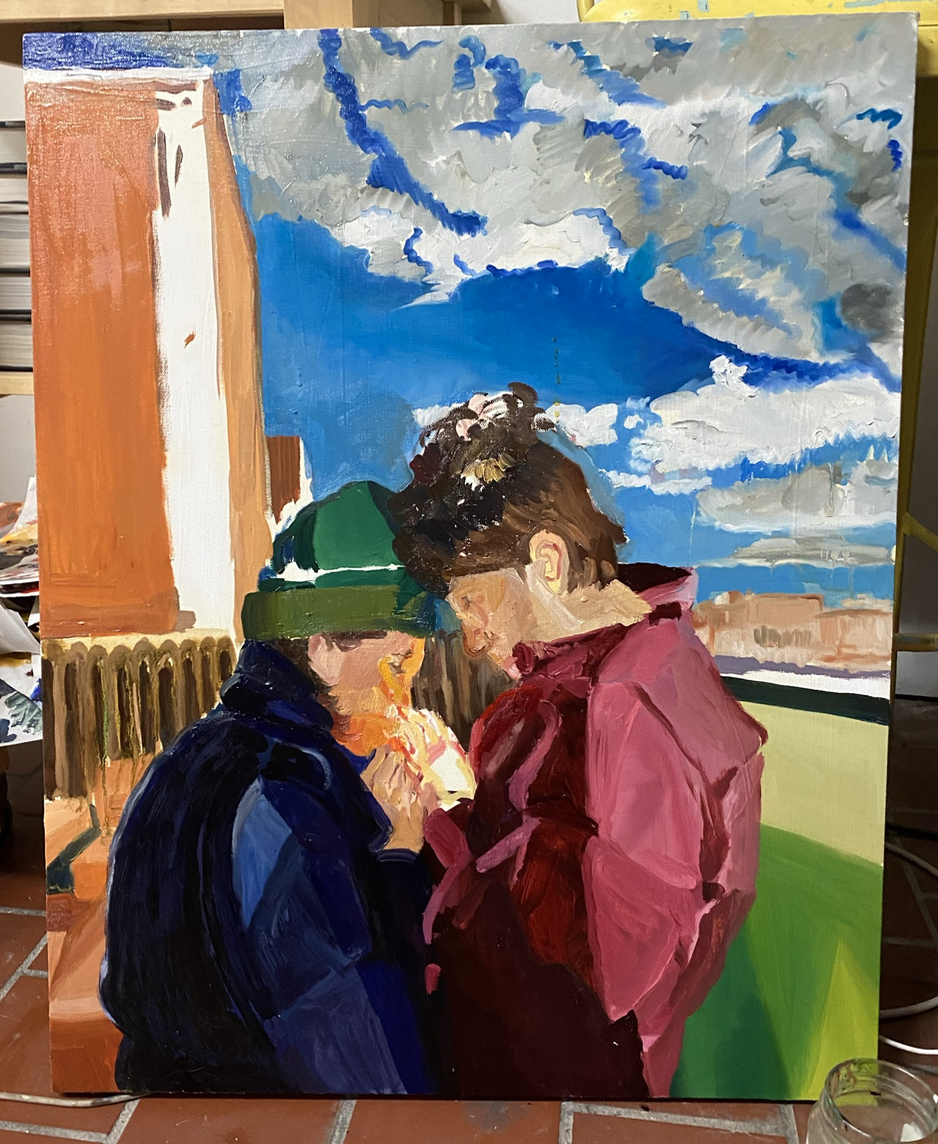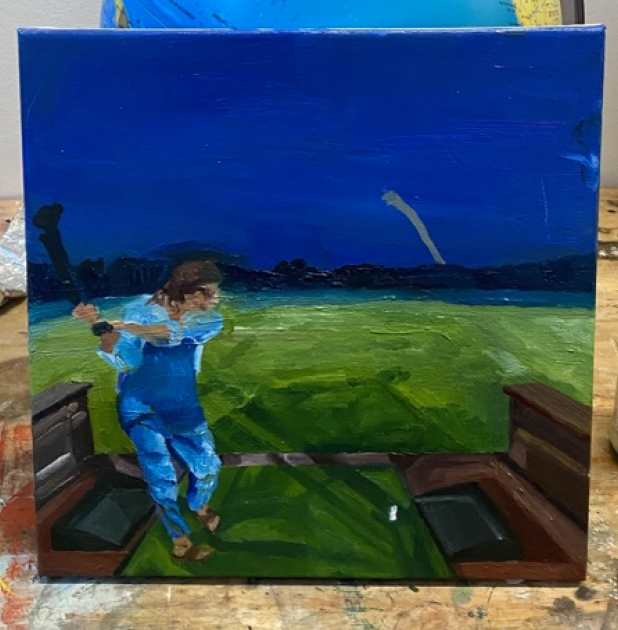
Photo by Naava Guaraca
Studio Diaries 3
NAAVA GUARACA SHARES HER READINGS, VIEWINGS, AND PROCESSES FROM THE END OF SUMMER. SHE EXPLORES HEALING AND CRISIS ALONGSIDE HER OWN ART MAKING.
By naava guaraca
10.6.2021
Thoughts, musings, etc:
The truth is the world has felt less inhabitable than usual lately. We’re plagued with a question that’s not new nor revolutionary in any way: how does one make art in times of crisis?
I’m part of the way through Close to the Knives, David Wojnarowicz’s titular memoir written during the height of the AIDS crisis. As he watches the government lie to absolutely everyone over and over, again and again, friends die and lovers are gone before he can blink. The neglect of a nation is a weight that surprises him. In today’s world, where I can hardly read a New York Times headline without having a full crisis breakdown, it’s strange to imagine being surprised by the government letting us down. A lot of people have died in the last year.
In the midst of another heavy August rainfall, I stopped into The Golden Notebook, a favorite bookstore in Woodstock, NY. I’d spent the last month working my way through Close to the Knives, and I’d recently started My Brilliant Friend by Elena Ferrante. Dense literature is difficult sometimes and with a brain full of internet-blended mush, words on a page sometimes swim. I wanted to read something fun. Something funny, even.
We Are Never Meeting in Real Life is a hysterical, wonderful breath of fresh air. I was first introduced to Samantha Irby and her quick wit through an instagram post made by Abbi Jacobson (of Broad City). Sam discusses her early college years, awkward sex experiences, the transition between growing up poor and suddenly being able to afford an expensive uber just for the sake of riding in style, being fat and staying fat, and all kinds of ridiculously mundane stories in between. Each essay is full of life and relief, a combination made possible only by Irby’s willingness to feel the truth in every situation.
I love reading essays. I do know this can be a hot button issue, as essay collections celebrate broken-up texts and some prefer to read an entire book all the way through as one complete unit. Some of my other favorite essay collections by one author (Joan Didion’s Slouching Towards Bethlehem, Leslie Jamison’s The Empathy Exams) do feel like the individual essays are separate units. It’s a natural occurrence in the genre, and not something that surprises me. We Are Never Meeting in Real Life is 272 pages of pure heart straight from Irby’s brain. Her personality and vibrant writing ties every anecdote together in such a way that makes the reading experience feel like a conversation. As the final page (which advertises her other books) says, “because sometimes you just have to laugh--even when life is a dumpster fire.”
If things feel too hard all the time, consider taking a break from doing any kind of real-brain-work and read something funny. A great place to start is Sam Irby’s substack. Do not underestimate the healing properties of a good laugh.
In the studio this past month:
I’ve spent a while working on this painting of my two friends on my roof:

As well as this small piece of my girlfriend taking a swing at a driving range:

The two pieces I’m currently working on that I’m really excited about are this one:The truth is the world has felt less inhabitable than usual lately. We’re plagued with a question that’s not new nor revolutionary in any way: how does one make art in times of crisis?
I’m part of the way through Close to the Knives, David Wojnarowicz’s titular memoir written during the height of the AIDS crisis. As he watches the government lie to absolutely everyone over and over, again and again, friends die and lovers are gone before he can blink. The neglect of a nation is a weight that surprises him. In today’s world, where I can hardly read a New York Times headline without having a full crisis breakdown, it’s strange to imagine being surprised by the government letting us down. A lot of people have died in the last year.
In the midst of another heavy August rainfall, I stopped into The Golden Notebook, a favorite bookstore in Woodstock, NY. I’d spent the last month working my way through Close to the Knives, and I’d recently started My Brilliant Friend by Elena Ferrante. Dense literature is difficult sometimes and with a brain full of internet-blended mush, words on a page sometimes swim. I wanted to read something fun. Something funny, even.
We Are Never Meeting in Real Life is a hysterical, wonderful breath of fresh air. I was first introduced to Samantha Irby and her quick wit through an instagram post made by Abbi Jacobson (of Broad City). Sam discusses her early college years, awkward sex experiences, the transition between growing up poor and suddenly being able to afford an expensive uber just for the sake of riding in style, being fat and staying fat, and all kinds of ridiculously mundane stories in between. Each essay is full of life and relief, a combination made possible only by Irby’s willingness to feel the truth in every situation.
I love reading essays. I do know this can be a hot button issue, as essay collections celebrate broken-up texts and some prefer to read an entire book all the way through as one complete unit. Some of my other favorite essay collections by one author (Joan Didion’s Slouching Towards Bethlehem, Leslie Jamison’s The Empathy Exams) do feel like the individual essays are separate units. It’s a natural occurrence in the genre, and not something that surprises me. We Are Never Meeting in Real Life is 272 pages of pure heart straight from Irby’s brain. Her personality and vibrant writing ties every anecdote together in such a way that makes the reading experience feel like a conversation. As the final page (which advertises her other books) says, “because sometimes you just have to laugh--even when life is a dumpster fire.”
If things feel too hard all the time, consider taking a break from doing any kind of real-brain-work and read something funny. A great place to start is Sam Irby’s substack. Do not underestimate the healing properties of a good laugh.
In the studio this past month:
I’ve spent a while working on this painting of my two friends on my roof:
As well as this small piece of my girlfriend taking a swing at a driving range:
And this one:
I’m getting close on that last one, and my girlfriend can’t wait for it to come home. I’ve hit a point around layer four where the troubles have mellowed out and the surfaces are ready for their details. This piece is reminding me of the joys of painting--it’s serving as a reminder that I can paint whatever the hell I want. That being an artist comes with the liberties of creating anything I can imagine. Learning a craft is hard and mastery begins with confidence.
Inspirations of the week:
- Niki de Saint Phalle, whose show, Structures for Life I caught at MoMA PS1 the last day it was open. Her sculptures that twist and turn, her constant revisiting towards childhood that allows the work room to breathe and imagine, the way she decorated the inside of bubble letters with little stripes. I wouldn’t dare compare her to a man, but if I did it would obviously be Gaudí, and I’m sure she’d be pleased. Most of all, she was on a quest to design playgrounds. I often feel as though my childhood came prepackaged for me, sitting on my doorstep and waiting until I turned 22. The casual nature of relating art to childhood makes sense when I think about my childhood as a dream delivered. Now I’m here, and here’s this thing I must unravel.
- David Wojnarowicz, to whom I’ll return to over and over for clarity and understanding. Who I’m thinking about as I think about Niki because of the time he wrote: “But what one sees if they look closely into the pupils of my eyes are a series of activities that are merely things that have occurred to me in the years of my childhood and teens” (Close to the Knives, 58). Whose rage and distaste for American neglect feels more prevalent than ever. For whom I feel anger and sadness and care, all at once.
- Anthony Cudahy’s painting Anti-Bausor Tree (protected sleepers, wolf’s-bane and spider around), oil on canvas, 96” x 72”, 2021. TLDR because this painting speaks for itself; I can’t wait to one day make something as magnificent as this.
